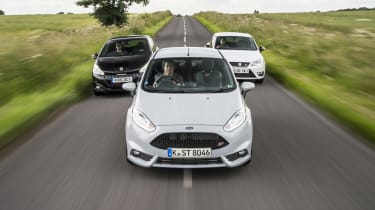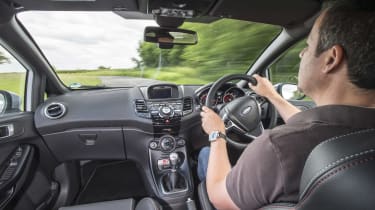Ford Fiesta ST200 v Peugeot 208 GTI v SEAT Ibiza Cupra - tiny terrors reviewed - Ford Fiesta ST200 v Peugeot 208 GTI v SEAT Ibiza Cupra - page 2
Is the Fiesta ST200 capable and engaging enough to see off the superb 208 GTI by Peugeot Sport, or the SEAT Ibiza Cupra?
Divorce yourself from the lack of character and the performance is impressive – the Ibiza has little trouble glueing itself to the other two – but the chassis isn’t sharp or incisive enough to make you want to push it beyond some settling understeer. The ride is supple enough and works well on our lumpen B-roads, but there’s little emotional or sensory connection.
Considering it has to pull some gargantuan gearing, the engine does a decent job, but when third gear will take you to three figures, any thoughts of scratching down your favourite road in a flurry of gearshifts are snuffed out in favour of staying in third or fourth and flexing the Ibiza’s strong mid-range muscle. It’s a swift, sure-footed hatch, but one that fails to tickle your adrenal gland or quicken the pulse.
And so to the Fiesta, which is immediately impressive. Everything feels right. You don’t have to adapt to any annoying quirks, the driving position feels spot-on, visibility is great. The Sony infotainment system is notoriously hopeless, but the comfortable, supportive Recaro seats and the driver-focused wraparound nature of the dash create an immersive feeling from the off.
> More: Ford Fiesta ST review - the unbeatable junior hot hatch?
The 212bhp 1.6-litre turbo motor is by far the most likeable of the three engines here. It’s vocal, with a rasp to its note that builds as you work through the revs. The power and torque deliveries are generous, so while the engine isn’t a screamer, it does have a perceptible peak that’s worth working towards. It sparkles from 4000rpm and fizzes all the way to 6500rpm. It gives you a reason to rev the car and work the six-speed gearbox, which is surely the point of a hatchback like this.
The shortened gearing plays its part, too. It’s not sprint gearing by any means, but you definitely have more fun more of the time simply because the car feels more urgent, and you don’t spend your time taking great bites out of a country road in one apparently elastic gear. The flipside is that every now and again you need to grab a quick upshift between corners then immediately knock down a gear, but this added effort is a small price that’s well worth paying. The shift can be fast, but it doesn’t feel especially mechanical – a minor gripe.
Accelerate hard in the lower gears and you can feel some torque-steer tugging at the wheel, but it’s contained so it doesn’t have a corrupting influence. The chassis rate of response is a little softer than in the Peugeot, but this makes it more natural and intuitive to guide. There’s plenty of grip and traction to call upon and the ESC button isn’t tucked away, so you know it’s there to be pushed when you’re in the mood. The ST200 doesn’t have the sheer bite of the Pug – largely thanks to having electronic torque vectoring rather than a mechanical limited-slip diff – but it’s a car that’s up for fun.
Ford has worked on the chassis, increasing the roll stiffness but relaxing the spring and damper rates a little for better composure on lumpy roads. It’s worked, the ST200 having a little extra compliance on roads that would have a regular ST a bit more agitated. It’s still a firm car, mind, but compared to the Peugeot it’s noticeably more supple (and pointier and more agile than the Ibiza). When you work to and beyond its limits, the ST200 retains that control and neutral composure, adding some useful throttle-adjustability if you have a play on turn-in. It doesn’t respond so well to really being bullied, so you quickly learn it’s a car that goes best and feels sweetest if you work up to and just beyond its limits. This is in contrast to the 208, which very much prefers being grabbed by the lapels and slung around.
> The best hot hatchbacks of 2016
Ask me how I’d rate these cars after my first drive and I’d have said the Fiesta wins by a mile, for it’s one of those cars that wins you over in minutes. By contrast the Peugeot seems to do what it can to put you off. The steering is darty and takes some getting used to and the chassis doesn’t seem to let you find a flow quite so readily. But as the miles and familiarity build, so you find yourself becoming more impressed by it. Explore its dynamics and you make more sense of its handling and feel, and while it isn’t as finely honed as the ST200, it’s a much closer call than first impressions would suggest.
Sadly the Ibiza is never really in the running, emotionally or dynamically. Though far from shamed in terms of point-to-point pace, it lacks the energy and infectious manner of the others. It looks bland, and that’s reflected in the overall driving experience. That’s not to say you can’t have fun in it, but the sentiment is similar to an unexpectedly enjoyable hire car rather than the kick you get from knowing you’re in a car that’s been expressly made for enthusiasts. It’s cheaper than the ST200 or 208, but it’s clear the extra money buys a lot more than snazzy wheels and seats. The Ford and Peugeot are both class acts, but the Fiesta ST200 just takes the win.



